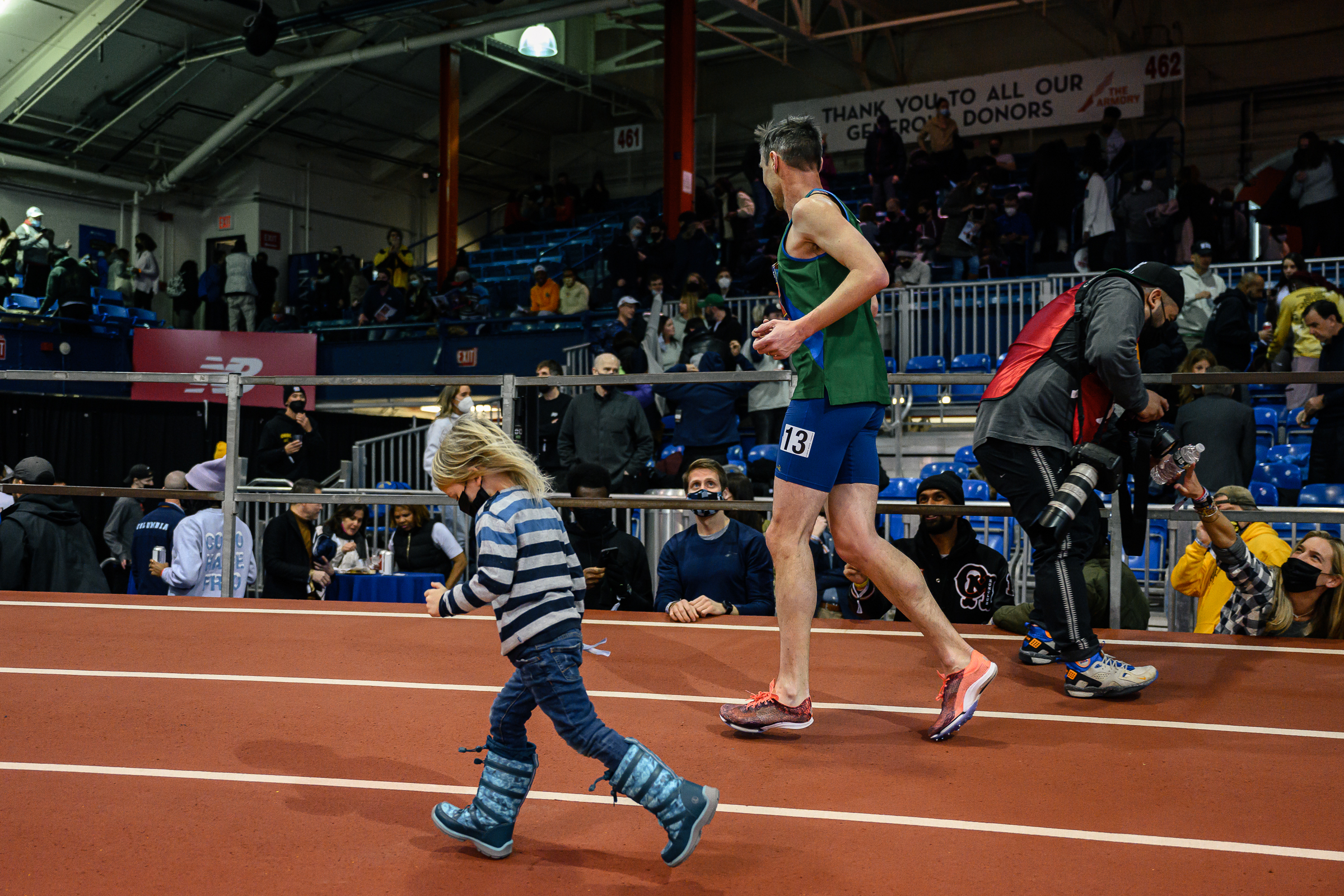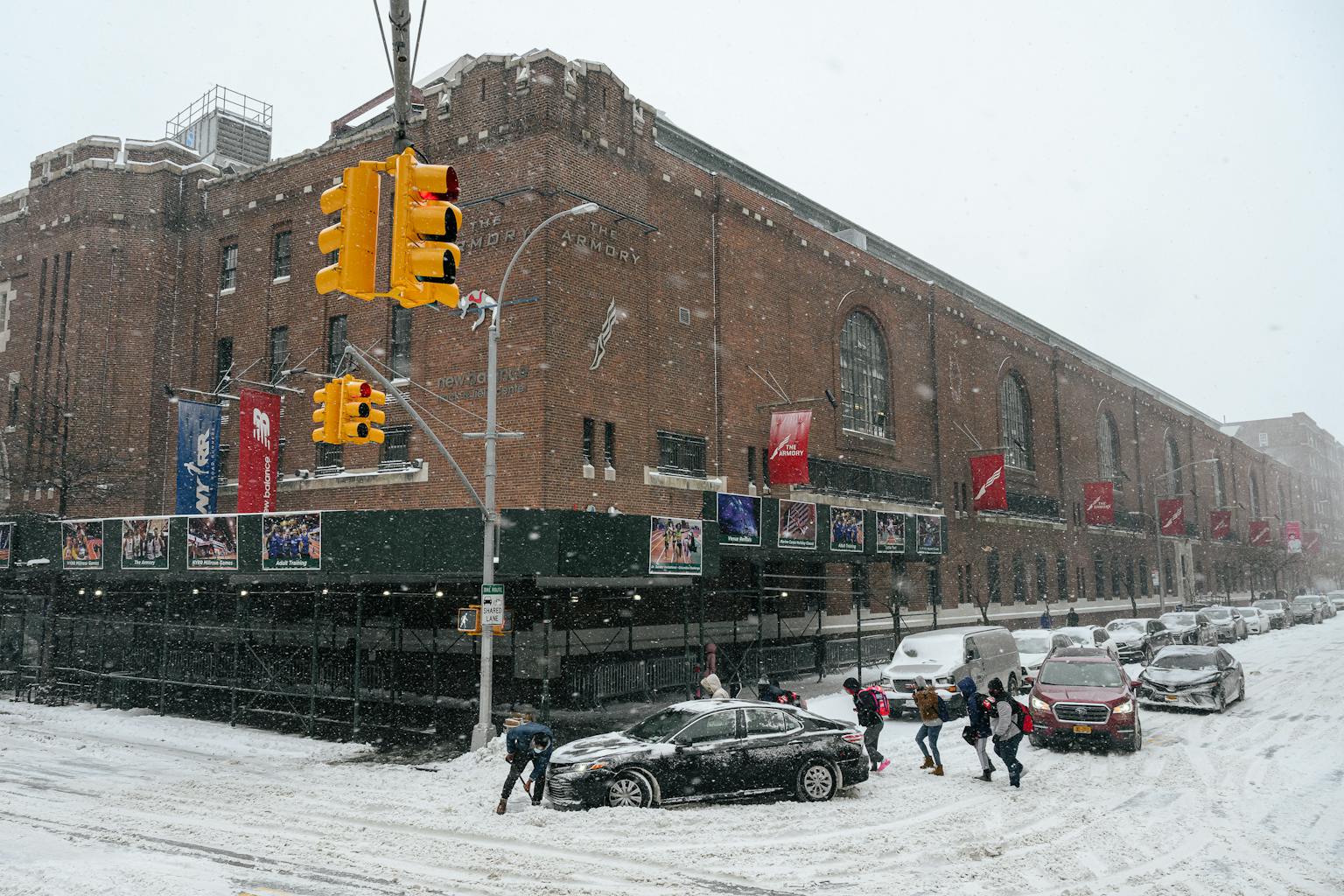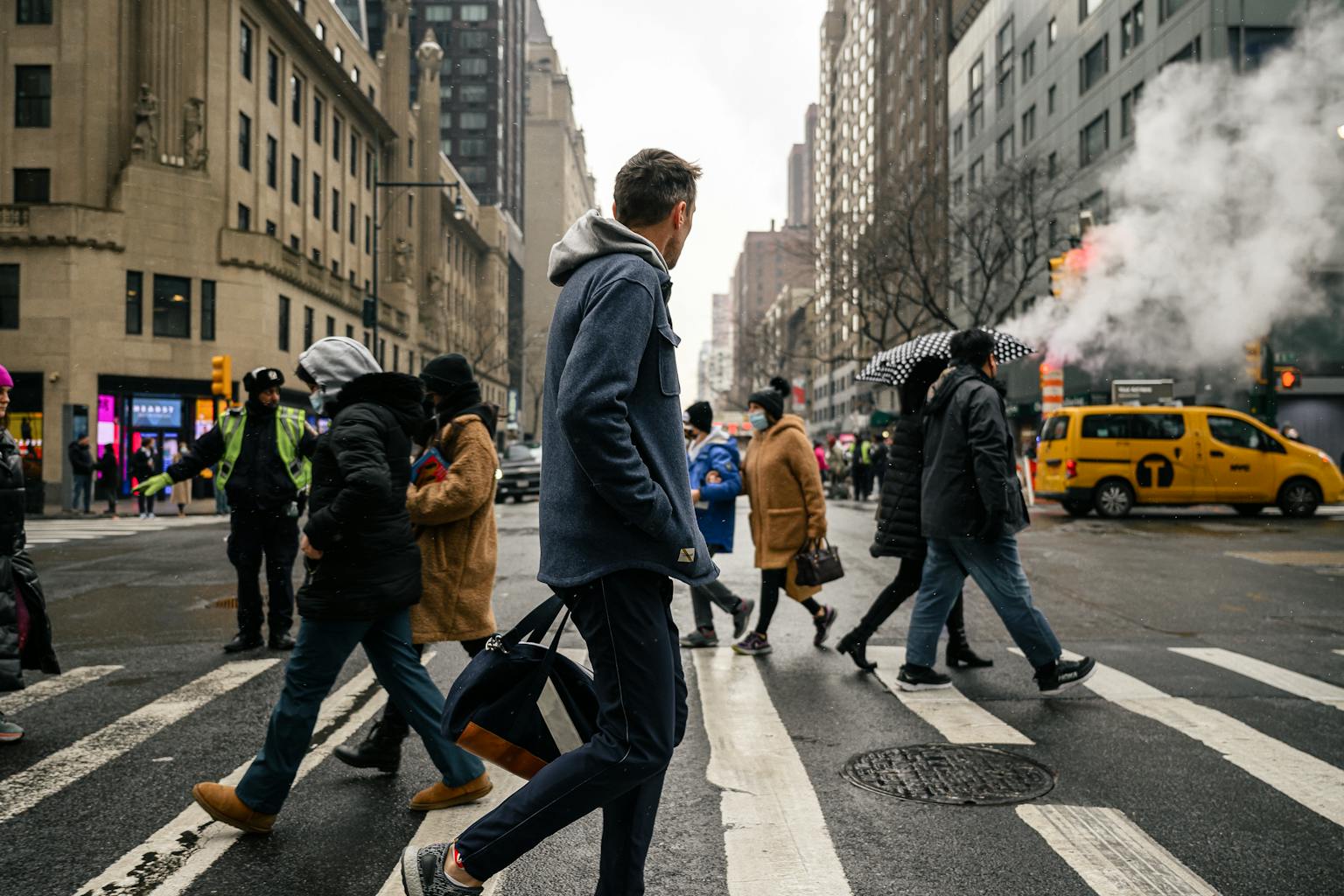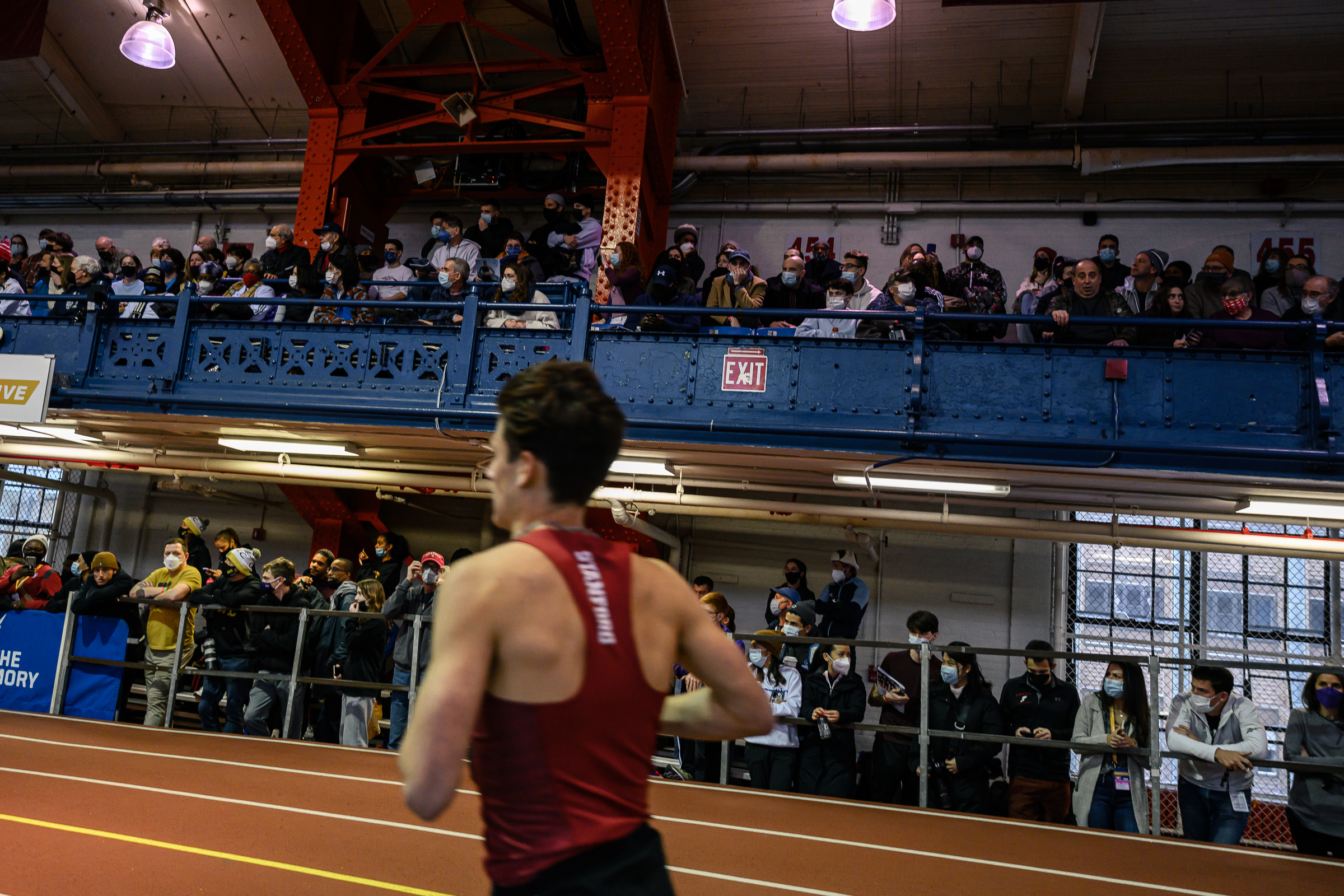
Magic at Millrose
Words by Devin Kelly
Photography by Johnny Zhang
For about 15 minutes this past Saturday, I sat inside Tasty Deli on the corner of 169th and Broadway. I was eating a Marco’s sandwich, one of the best sandwiches in New York City. Outside, people high-knee’d their way over snowdrifts, descended into the subway station, made their way to or from wherever it was they had to be. Across the street, Coogan’s – the rare pub that celebrated and honored track and field – was boarded up after having closed in early 2020. If you sat where I was sitting, looking west down 169th, you might not have known that the most prestigious indoor track meet in America was happening just down the street. If you sat for a few minutes, you might have wondered about the occasional groups of people shuffle-running past, trying not to slip as they shook out their pre-race nerves. You might not have even been aware of the Armory, its thick bricks muffling the electric hum and bustle on the other side of its walls. Step into the Armory, though, and you would feel it all immediately. The sharp, biting fluorescence. The endless swell and ebb of noise. The nervous chatter. The almost shocking sensation of cold air cut through immediately, and without warning, by the hot steam of a centuries-old radiator. And, through the din of noise, like clockwork: the sound of feet falling and lifting and falling again upon an indoor track.
There is something about indoor track that is wildly exciting, a testament to the way in which structure informs the energy of an event. Outdoor track – any track event at all – is exciting, yes. I dare anyone to look away from the 10 seconds of a 100 meter dash. But take that same kind of event indoors, and take away the possibility of a distant horizon to gaze upon, and something changes. Part of that, I feel, is due to the extreme contrast. It is a moment of pure intoxication to walk through the snow and frigid cold into a building full of clanging radiators and exposed pipes. At the Armory, the 200 meter indoor track barely fits inside, which means that nearly every inch of space that could be used for spectating brims with people. Fall out of the front row of the fourth floor balcony, and you’ll land on lane six of the third floor’s track. As such, an indoor track meet – especially at the Armory – is an act of pressure cooking: all this energy, and nowhere for it to go, so it only builds and builds and builds.
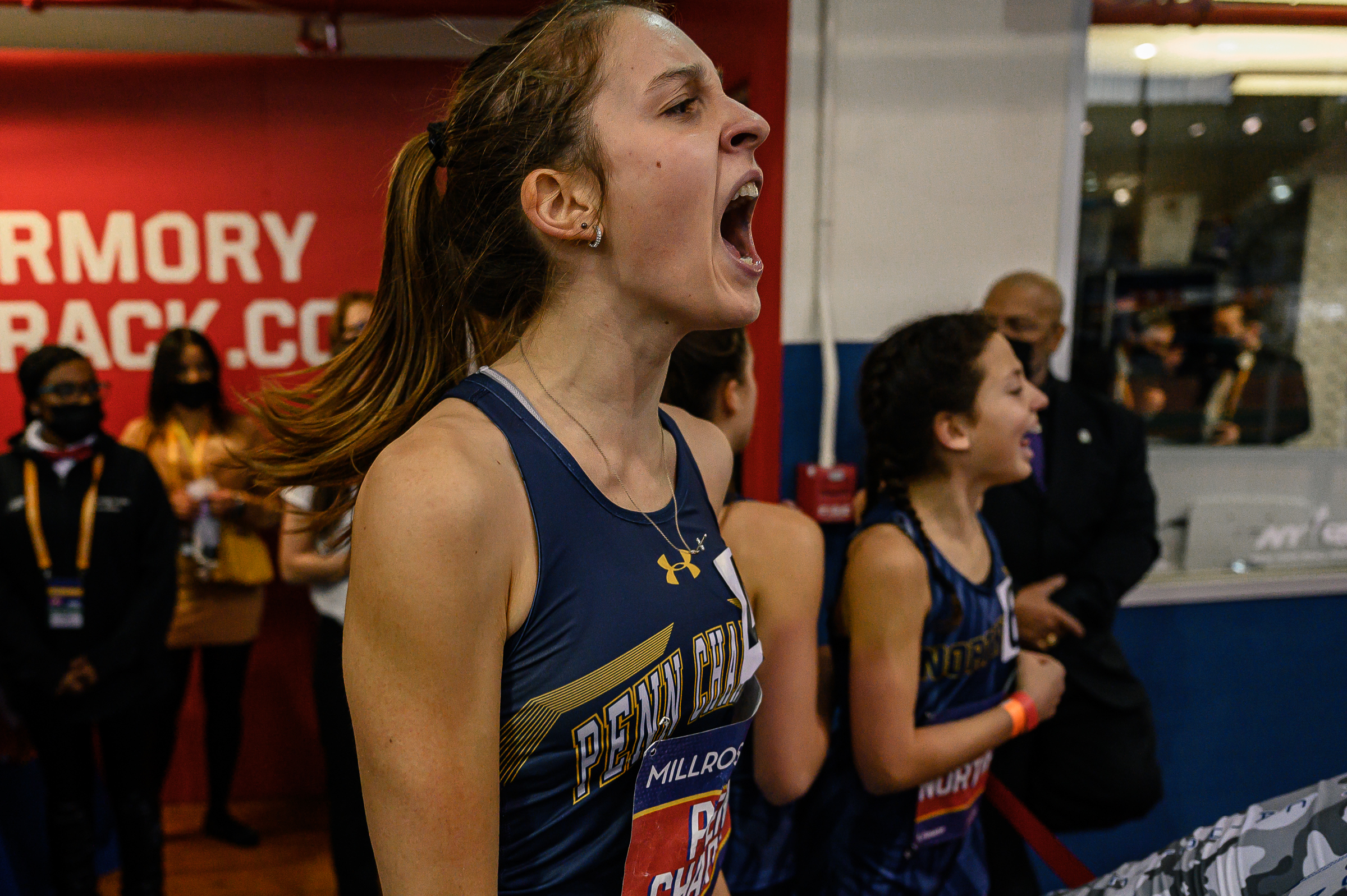
That’s part of indoor track’s history: the excitement of spectacle made even more exciting by proximity and oddity. For a brief period at the end of the 19th century, New Yorkers were held in awe by pedestrianism, perhaps the simplest sport of all time. For years in the late 1800s, thousands of spectators would gather at Madison Square Garden to watch six-day endurance walks. Sleeping on cots in the middle of an eight-lap-to-a-mile sawdust-covered track, athletes had one task: cover as much distance as possible in six days. They could run, walk, crawl, and scratch and jab at one another. The sport was an absolute frenzy. During one 1879 race, an angry mob of thousands rioted outside, demanding to be admitted. During another race, 300 spectators snuck into the Garden through a chute used to deliver coal. Nearly always, spectators crashed through barriers, just to get closer to the athletes, to hear them make quips like “[this pace is] more for hares than turtles” before dropping out, limbs askew, probably smelling of cigarettes and whiskey. Newspapers published daily reports and updates of each athlete’s distance. It was the talk of barber shops and hotels. Anywhere in the city, you could find an answer to the question: how far had the athletes traveled?
Before I took that quick break to get my treasured sandwich, I had arrived early at the Millrose Games, most likely long before any of the professionals were there. This is in large part because I know a little secret. Years ago, my brother – who runs for the GRC racing team in Washington, DC – ran the opening leg of the Club DMR, the very first event of Millrose. It was then that I realized: there’s a whole track meet that takes place before the TV lights turn on, and track fans across the nation tune in. I arrived this past Saturday just in time for that same race, where a few local and regional clubs meet each year to battle it out on the 200 meter track. It’s the first event of the day, and one of my favorites, mostly because of how intimate it feels. The crowd is sparse, limited to only each club’s teammates and their loyal fans. But the racing is always top-notch.
As I stood there watching, I couldn’t help but think that maybe this was what it was all about. Not the pros, but the amateurs. These really talented runners who commit themselves to getting better each day, despite the fact that they’ll never become professionals. After the men’s DMR, I talked to one of GRC’s anchor legs, Elias, who split 4:10 for the 1600. He’s 25 years old, working full time, trying to balance a deep desire to run fast with the responsibilities of living. I asked him why. Why try at all? He told me he wouldn’t be satisfied if he stopped, that he loved “running the way I want to run,” even if it meant “accepting the arbitrary.” The arbitrary: the act of chasing a goal that means something only to you. Something unexplainable. Hard to define. But there. I thought of all the times I have waked early and walked to Central Park to begin my run in the dark of just-before-dawn, and how, in the half-light, I have made out the shapes of the esoteric and determined groups of people running for Central Park Track Club, doing mile repeats in the cold: before work, before the other demands of life, before caregiving and caretaking and loving and living and dying. When I asked Elias when, or if, he would stop, he said he would run until he died.
It might sound excessive, but I get it. Once the sport hooks its spikes into you, it’s hard to leave. I’ve never raced at Millrose, but in the years I spent running for Fordham University’s track team, I found myself on the Armory’s track countless times, often in these big, non-invitational meets that had six or seven heats for the mile. And even then, running in the slowest or second slowest heat, I’d still see my dad trackside, banging on the rails. I’d still feel something nervous and electric pouring through me, my body a nest of rattlesnakes. And whatever crowd was there would nearly always stop its aimless chatter for the few minutes a race was on the track. I could feel the crowd, even if I knew they didn’t know me at all. They groaned and cheered, letting out these low vowel sounds to warn a runner that they were about to be passed. If you had your back turned to the race, you could still feel its drama. It’s like cinema, the Armory is. There’s a movie playing every few minutes, and everyone tunes in.
It was fitting, then, that a slew of master’s races followed the Club DMR. I stood trackside and watched a series of 4x400 meter relays, the first of which was mixed-gendered, and featured men and women racing against and among each other. I was spellbound as these 40, 50, 60, and even 70 year old men and women poured their souls onto the track through their hearts and lungs and legs. In one race, I watched someone go wide on the turn, arms high, face contorted into something so full of effort that I held my own breath. This was competitive drive, yes, but it was also beauty and grace. These were bodies. And though some still had the same fluid mechanics that the mostly young professionals would show off hours later, many of these runners had idiosyncrasies given to them by age and, I imagine, injury: jerky arms and legs, tight hamstrings that hiccuped their stride and limps that made me wince each time I saw a single foot fall. As such, to watch them run was to watch real humanness on display. It’s hard, I know, to age. But to put that aging on a pedestal, under the bright lights of the Armory, to say this is my body and this is how I allow it to run – that’s vulnerable, inspiring, and beautiful. It shows that any act of life is almost always an act of courage.
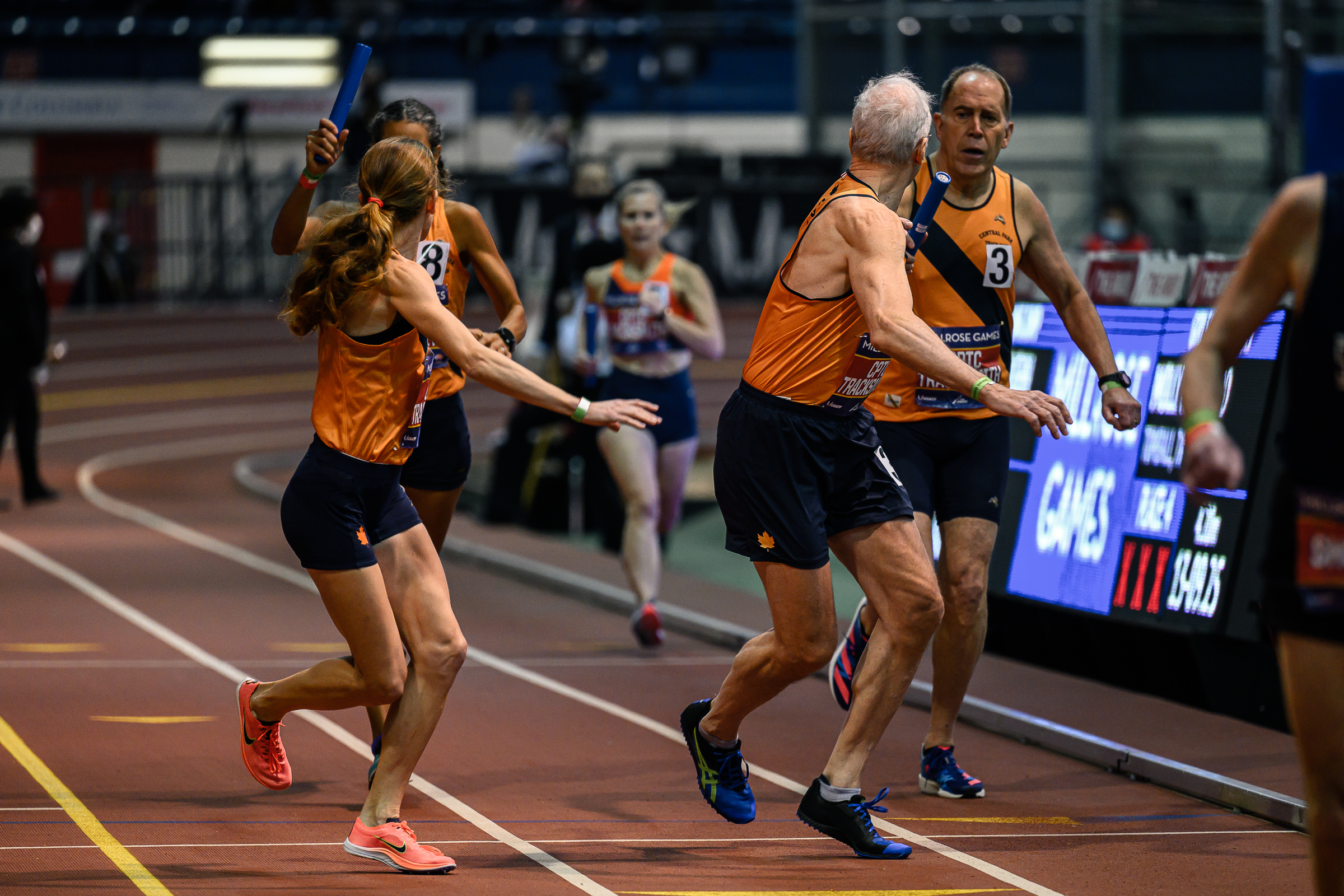
Afterwards, I stood among a group of women from Central Park Track Club, each of them over 60, grinning wildly in the aftermath of competition. I asked Sherrel, the 71 year old who ran the team’s leadoff leg, why she still went out there and competed. She said, simply: “Because I am and I can.” Her teammate, Tomomi, answered the same question by saying: “So I can show my two boys that I can.” Here they were, these enduring testaments to the grace that comes with a love of sport. I wanted them to be on TV, to have the world watch these people trying, amidst so much else that they must have juggled and still juggled, have endured and still endured. Yes, simply trying. And trying so well. The moment I walked away, I came across four men – wiry and spirited – who were debriefing their race with the chatty joy of high schoolers. They were members of Mass Velocity, and had the look of people who had been running together for decades. Stephen, 64 years old with the energy of a little kid, told me he kept running because he owed it to his younger self. I kept those words in my mind as the day progressed, particularly the words of Stephen’s teammate Peter. “Because of injuries and illness,” Peter told me, “running has almost been taken from me four times, so I treasure every moment.”
I found it important to center Peter’s words because, not long after the master’s races, the excitement began to build for the upcoming professional races, and many of the people who had just run were relegated to the past, maybe even forgotten or hardly ever seen amidst the bright lights and media photographers. The talk was of big events and fast times. I was excited, yes, but also a little sad. I wanted more talk of the purity of effort, the joy of being able to give that effort, and to give that effort among people. That was when I slipped out of the Armory and trudged through the snow, sometimes leaning sideways to let a runner pass, marveling at how they did not fall. I wanted a moment to myself. I ate my Marco’s in peace, watching people trudge through the snow to the so-much-else of life, seeming wholly unaware of this stadium of accumulating effort just a block away. I remembered all the times my teammates and I would finish our cooldown and hustle over to Tasty Deli, eating our same sandwiches with hungry desire, forgetting our fast times, our slow times, our not-so-great moments. I have forgotten so much about my track days, but I remember those moments: how happy we felt then, to be doing such a thing together.
I was lucky, then, that when I got back to the Armory, I found myself standing beside Ron Warhurst, the famed former University of Michigan coach. Magnetic and personable, Warhurst is someone who reminds you of something intangible. Standing next to him, I felt like a kid again. I had a hard time making conversation; I just wanted to listen to his quips and asides, his ever-present commentary. Warhurst now coaches two professional runners at different ends of their careers: Hobbs Kessler, the young standout who set the indoor high school mile record, and Nick Willis, the 38-year-old who was attempting, at Millrose, to break 4 minutes in the mile for the twentieth consecutive year.
There’s a real democracy to indoor track at the Armory. There’s no special space. The professionals linger in the same area as everyone else. They warm up outside on the same snowy block as all the other runners, or do their drills in the same tunnel of mondo-surfaced flooring that sits below the track. That tunnel is sacred. Narrow, smelling of tiger balm and piss (the bathrooms are there too), it is a bastion of nervous energy. High schoolers sit, backs to the wall, listening to pump-up music on headphones as professionals move through their pre-race routines right near them. It would be like going to some long-past literary reading to find Toni Morrison making final edits on a piece while someone anxiously worked up the courage to read a poem at the open mic that happened just before. In the same way, Mike Smith, the lauded coach of Northern Arizona University, spent much of the event standing just behind me, his athletes sitting with their backs to the grating that separated them from the Armory’s outer brick wall. That’s the privilege of indoor track. You can watch some of the best in the world be the best in the world while you are close enough to graze a hand along their shoulder. It’s something that’s missed in all the broadcasts and commentary – the way these professional runners still have to, because of the confines of the space, act like anyone else. What is broadcast to the world most often is pure success or failure – the high peaks and low valleys of athleticism, the drama solely of the track itself. But what is often neglected is the humanness, the way that professionals are anxious and nervous, are bodies just the same.
That’s the real spirit of the sport. In the end, it’s nothing special. It’s running. Some people do it faster than others. But so many people love to run. So many people love to have their feet on the track, turning left forever, chasing some beautiful dream that they have and that few others can understand. This is why I love that the amateurs get to run on the same track as the pros at an event like Millrose. There’s something special about the way they go first, leaving what they can of their souls on the track as they run. They remind those of us who watch of the beauty of the why while the pros show us the beauty of the what.
Sometimes, though, both the why and the what intertwine, and something amazing happens. That was the case when Nick Willis lined up in the final race of the day to chase that inconceivable goal: 20 consecutive years of running under four minutes for the mile. Before the race, I watched as an anxious Hobbs Kessler jogged over to Warhurst and leaned over the trackside rail for some last-minute advice. The advice? “Put the grin on, boy. And have fun.” Kessler, just 18, was most likely nervous. The mile at Millrose is a star-studded event, and I imagine that the jitters of running as a young professional were probably compounded by the fact of his teammate’s attempt to break four. But Warhurst’s words served as a tender reminder of the why. I couldn’t help but think of how one of Sherrel’s masters teammates, Ivy, told me that “joy” and “gratitude” were two of the most important words that running brought to her mind. Or how Brock, a 44-year-old runner who competed in one of the master’s 4x400 relays, told me that running at Millrose was “like coming back to be with your friends again.” Or how Drew Hunter, the young professional, after placing sixth in the 3000 meters, told me that, during the race, he kept trying to remind himself of “how grateful [he was] to be back here.” When Warhurst told Kessler to put a grin on his face, he was reminding him of that same why, a why of joy and gratitude, one that had more to do with something more universal than anything else.
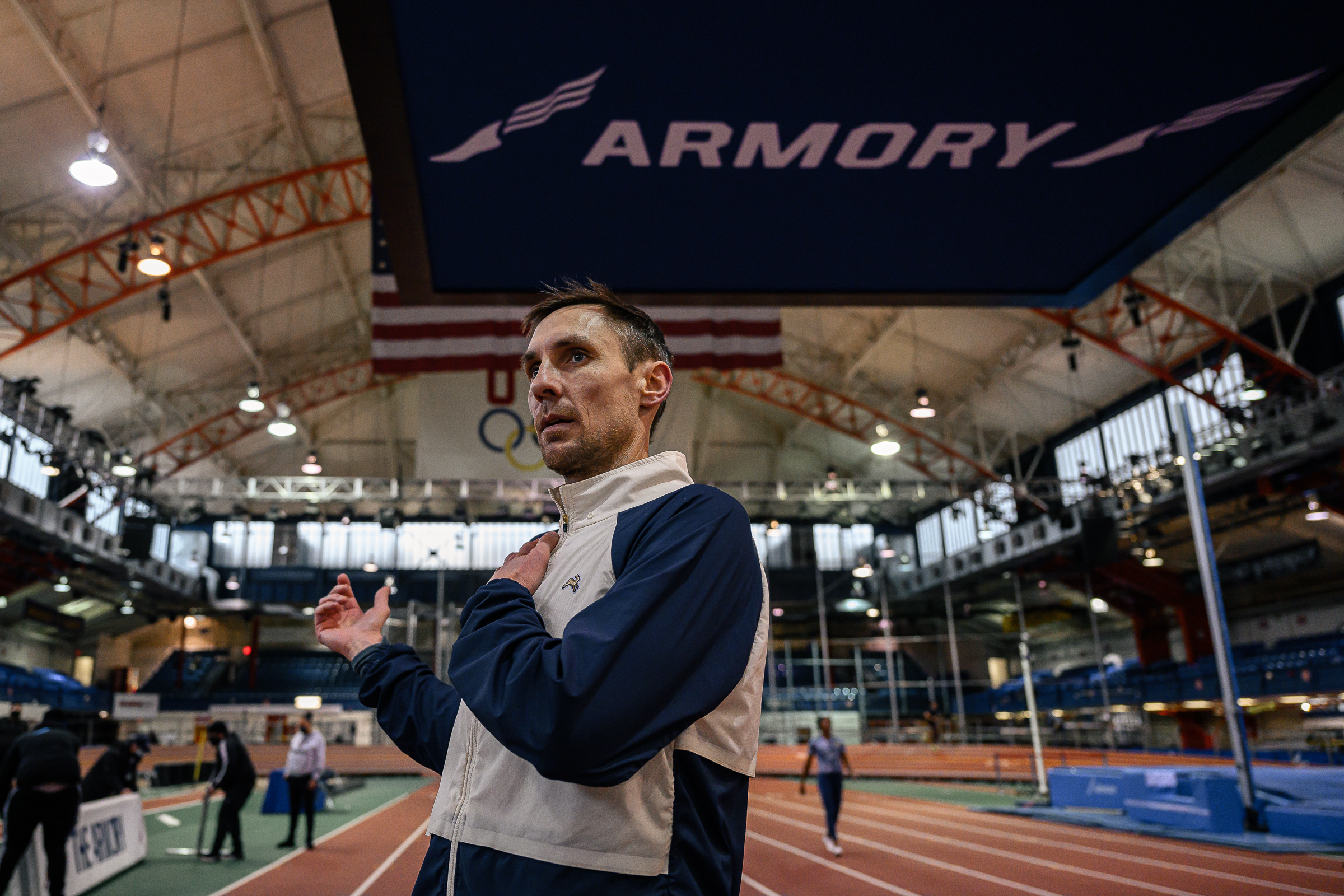
I think sometimes that we think there is a gulf between the people who do things extraordinarily well and the people who make up the wide belly of the bell curve. But the truth is that such a gulf is perhaps nonexistent, and that everyone is mostly ordinary in nearly all ways, and that ordinariness, in general, often means a shared love and value of certain truths. The truth of friendship, for example. The truth of joy. The truth of gratitude. It also means that professionals go through so much that the TV cameras don’t show. They nervously stretch and re-stretch jittery calves. They fumble for words, experience failure, make excuses, and don’t make them. They talk to friends and pose for pictures. They lean in for advice from a coach, maybe hoping there’s an easy answer, and knowing that there isn’t one. They hide, sometimes, in the shadowy nooks that the Armory provides, just like I sometimes did, escaping the feeling of failure or trying to deal with the ceaseless nerves of something that – even though it meant nothing much to anyone at all – meant more than words could explain.
I’m thinking of that phrase that Elias said, hours before any professional lined up to race. Accepting the arbitrary. It’s a real thing. And the sport of track is the pinnacle of the arbitrary. Just seconds dictate the distance between an amateur and a pro. And meanwhile, thousands upon thousands of people lace up their shoes to chase a goal in a track race or a 5k or a marathon that only they really understand. Because how do you put into words what it means to find something within yourself, and spend a day, and then another, and then another, trying to make it a little more beautiful? You can’t, can you? You can only just go out for a run.
When the gun for the Wanamaker Mile went off, Nick Willis went straight to the tail end of the pack. It was a fast race, and it immediately strung out. But Willis wasn’t alone. Kessler was always a step ahead, trying to show the way. I couldn’t watch the front of the race. I was trackside the whole time and have no idea what happened up there. I was watching Willis, the high lift of his knees and his almost gentle footfall. Beside me, Warhurst held an old stopwatch, looking at splits and growing a little concerned at the slowness of their early pace. At one point, as Hobbs pulled Nick around the turn, Warhurst took off his Michigan cap and waved it around in the air. He wanted them to go, to move, to pick it up. And they did. There are moments in life when the world falls away, and whatever personal anxiety you have falls away and is replaced by a fixation on something pure and beautiful in front of you. I could’ve looked at Hobbs and Willis’ faces the entire time. There was a whole life’s journey contained in those eight laps.
Nick Willis broke four minutes for the mile. He did it with his teammate, Hobbs Kessler, just in front of him the entire time. When I spoke to Nick after the race, he told me: “If it wasn’t for Hobbs, I wouldn’t have gotten that time today.” He said that what motivates him now is the “social aspect” of running: being around friends and a magnetic, personable coach. It was, essentially, the same thing Sherrel told me. And Tomomi. And Ivy. And Stephen. And Peter. And Brock. And Drew. In a world where so much is arbitrary, there’s a real beauty and joy to be around those who can help you make sense of yourself, your goals, and all the ways both of those things change. You share the track together, and you make a world that way.
Lingering after the final race of the day, I watched professionals who had just raced each other join one another for a few cooldown laps on the same track where they had just battled. I watched some who had bad races by their standards break into smiles, made to laugh by the people who had beaten them or who they had just beaten. I watched Nick Willis jog a lap with his toddler son. And, I imagine, the people who I had watched earlier – the amateur runners and the masters athletes – were taking trains or cars home to their families, were catching up on work or icing their muscles. Were doing the things, in other words, that ordinary people do: tending to themselves, despite so much, and because of so much. Sport is and is not a thing to be taken lightly. The what of it floats, sometimes, back and forth in the wind. You get faster, and then slower, and then faster again, and then slower. This happens forever. It is one story of life. But the why is another story. The why is beautiful.
